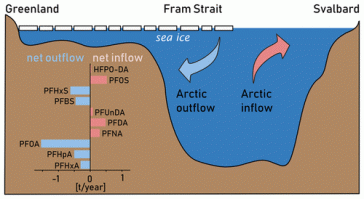
While two of the most notorious PFAS compounds—PFOA and PFOS—have been voluntarily phased out of production by industry in the United States and Europe, they are still widely detected in the environment. Intended as a safer replacement for PFOA, hexafluoropropylene oxide-dimer acid (HFPO-DA or colloquially known as “GenX”) is now thought to pose similar health concerns and be just as persistent in the environment. Collaborating with researchers from the Helmholtz-Zentrum Geesthacht in Germany, Dr. Elsie Sunderland, STEEP Project 1 lead, and her PhD student, Charlotte Wagner, were involved in a recent study investigating the long-range, oceanic transport of PFAS to the Arctic Ocean. The study analyzed 29 PFAS compounds in seawater samples collected from an icebreaker research ship along a transect from Europe’s North Sea to the Arctic in the summer of 2018.
The researchers detected 11 legacy and replacement PFAS in the ocean water, including PFOA, PFHpA and PFNA, and for the first time in Artic seawater, HFPO-DA. This provides evidence for its long-range transport to remote areas. Two east-west transects were analyzed in Fram Strait, located between Greenland and Svalbard, which is a major gateway to the Arctic Ocean. The seven depth profiles revealed higher PFAS concentrations in the surface water layer than in intermediate layers and a negligible amount at depths below 1000 meters. The total PFAS concentration was higher in the surface water exiting the Arctic than the water entering the Arctic Ocean from the North Atlantic. The PFAS composition in the outgoing water indicated a greater importance of atmospheric deposition compared to ocean circulation, and a higher retention of the long-chain compounds in melting snow and ice.

